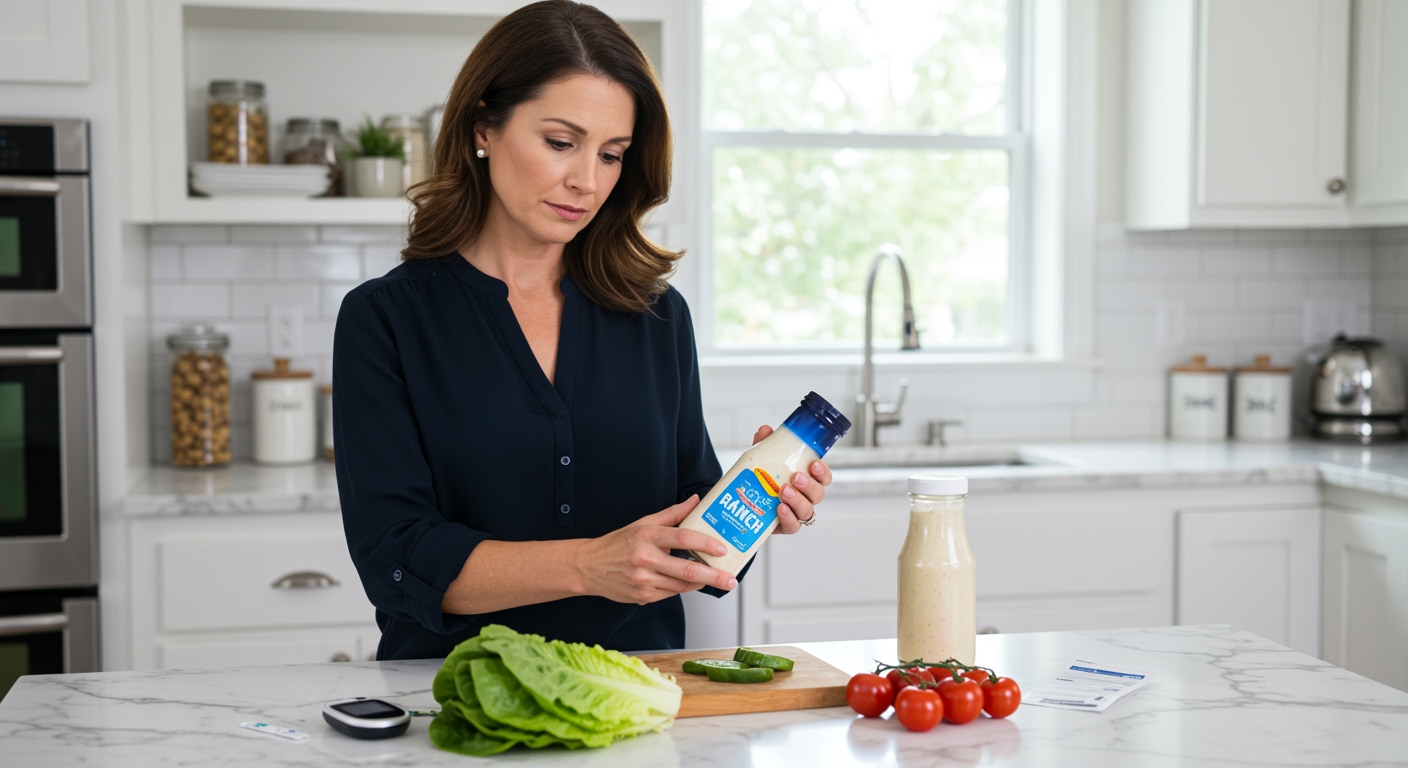✪ Key Takeaway: Ranch dressing can raise blood sugar due to hidden sugars and should be consumed in small portions by people with diabetes.
Introduction
You reach for that bottle of ranch dressing to make your salad more enjoyable, but then you pause.
Living with diabetes means questioning every food choice, and condiments like ranch dressing often create confusion about their impact on blood sugar levels.
Hi, I am Abdur, your nutrition coach and today I am going to explain everything you need to know about ranch dressing and diabetes management.
What Makes Ranch Dressing Problematic For Diabetes?
Ranch dressing contains several ingredients that can affect your blood sugar levels in unexpected ways.
Most commercial ranch dressings contain added sugars in forms like high fructose corn syrup, sugar, or dextrose.
These sugars get absorbed quickly into your bloodstream, causing rapid spikes in glucose levels.
A typical two-tablespoon serving of ranch dressing contains about 2-4 grams of carbohydrates, with much of this coming from added sugars.
The glycemic impact becomes more significant when you consider that most people use more than the recommended serving size.
Ranch dressing also contains preservatives and stabilizers that may interfere with insulin sensitivity over time.
✪ Fact: Two tablespoons of ranch dressing contain as much sugar as half a teaspoon of table sugar.
How Does Ranch Dressing Affect Blood Sugar Levels?
When you consume ranch dressing, the added sugars enter your digestive system and get broken down rapidly.
Your body absorbs these simple carbohydrates within 15-30 minutes, causing your blood glucose to rise.
The fat content in ranch dressing can actually slow down this absorption process slightly, but it does not prevent the blood sugar spike.
For people with diabetes, this means your pancreas must work harder to produce insulin or your medication needs to manage the additional glucose load.
The combination of fats and sugars in ranch dressing can also contribute to insulin resistance when consumed regularly.
Studies show that high-fat, high-sugar combinations can impair your cells ability to respond effectively to insulin signals.
This creates a cycle where you need more insulin to achieve the same blood sugar control, making diabetes management more challenging over time.
✪ Pro Tip: Test your blood sugar 2 hours after eating ranch dressing to understand your personal response.
What Are The Hidden Ingredients You Should Avoid?
Reading ingredient labels becomes crucial when choosing ranch dressing for diabetes management.
High fructose corn syrup appears in many commercial ranch dressings and causes rapid blood sugar spikes.
Maltodextrin is another hidden ingredient that has a higher glycemic index than table sugar.
Modified food starch can also contribute to carbohydrate content and affect blood glucose levels.
Artificial preservatives like sodium benzoate may interfere with your body natural insulin production mechanisms.
Some ranch dressings contain trans fats or partially hydrogenated oils that increase inflammation and worsen insulin sensitivity.
The sodium content in ranch dressing can also be problematic since people with diabetes have higher risks of developing cardiovascular complications.
✪ Note: Always check the first five ingredients on the label as they make up the majority of the product.
Can You Make Diabetes-Friendly Ranch Dressing At Home?
Making your own ranch dressing gives you complete control over the ingredients and sugar content.
Start with a base of Greek yogurt instead of mayonnaise to reduce calories and add protein.
Use fresh herbs like dill, chives, and parsley to create the classic ranch flavor without added sugars.
Add garlic powder, onion powder, and a small amount of apple cider vinegar for tanginess.
A pinch of stevia or monk fruit sweetener can replace the sugar found in commercial versions.
This homemade version contains virtually no carbohydrates and provides beneficial probiotics from the yogurt.
You can prepare a batch that lasts for up to one week in the refrigerator, making it convenient for meal planning.
✪ Pro Tip: Homemade ranch dressing with Greek yogurt provides protein that helps stabilize blood sugar levels.
What Are The Best Store-Bought Alternatives?
Several companies now make sugar-free ranch dressings specifically designed for people managing diabetes.
Look for products that use natural sweeteners like stevia or erythritol instead of artificial sweeteners.
Organic ranch dressings often contain fewer preservatives and use higher quality oils.
Choose dressings with less than 2 grams of carbohydrates per serving to minimize blood sugar impact.
Avocado oil-based ranch dressings provide healthier fats that support better insulin sensitivity.
Some brands offer portion-controlled packets that help you stick to appropriate serving sizes.
Always compare nutrition labels and choose options with the lowest sugar and sodium content available.
✪ Fact: Sugar-free ranch dressings can contain up to 80% fewer carbohydrates than regular versions.
The Bottom Line
Ranch dressing can be part of a diabetes-friendly diet when you choose the right type and control your portions carefully.
Small changes in condiment choices can make big differences in blood sugar management over time.
I would love to hear about your experiences with ranch dressing and diabetes management, so please share your thoughts or questions in the comments below.
References
At NutritionCrown, we use quality and credible sources to ensure our content is accurate and trustworthy. Below are the sources referenced in creating this article:
- Tap Health: Can People with Diabetes Eat Ranch Dressing?
- Glycemic Index: Salad Dressing Ranch Dressing Regular
- Milk and Honey Nutrition: Best Salad Dressing for Diabetes Store Bought Homemade Options
- FoodStruct: Ranch Dressing





